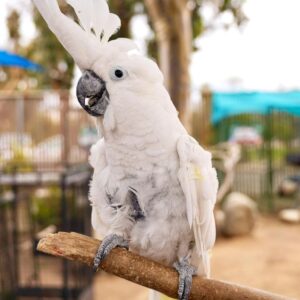In the bird world, blue-crowned parakeets are usually called blue-crowned conures. They like to be around other birds and can talk better than some other conures. People like to keep them as pets because they are thought to be one of the “easier” birds to take care of. They need a lot of care and a cage with lots of room and toys, though, because they are smart and full of energy. Also, they can get pretty loud. They are better as pets for serious bird lovers than for casual birdkeepers because of this. Blue crown conure for sale
There are a lot of blue-crowned conures in South America, from eastern Colombia in the north to northern Argentina in the south. They are small green Neotropical parrots with blue heads and pale beaks. It lives in savannas, woods, and rainforests in its natural environment. Medium-sized birds like the blue-crowned conure are about 37 cm (14.5 in) long and weigh between 140 and 190 g (4.9 and 6.7 oz).
The top of a blue-crown’s head is red when it is born, but most of the bird is green, with a dull blue color on the face, crown, cheeks, and ears in the nominate species and less blue in others. Around each eye is a ring of white skin without feathers. In the wild, this is bright orange-yellow rather than white. Sometimes the breast feathers have a blue tint to them, but most of the time they are green to yellow-green.
Care
Once every two months, cut the bird’s nails. Check the wings often for new feathers and cut them off as needed. Their favorite thing to do is take warm water spray showers, and it’s beautiful to see them soak alone in a dish of warm water.
That being said, you shouldn’t leave this bird in a cage all the time. If you see a blue-crowned conure in the wild, it will be with a group of other birds. You will have to be its flock mate while it is in captivity.
A blue-crowned conure might be happy with another bird to play with during the day if you aren’t around much. The bird might also be happy if you leave the TV or radio on when it’s by itself in the house.
Feeding a Blue crown conure
A diet that is equally diverse and includes fresh fruits, vegetable greens, and high-quality pellets is essential for conures kept in captivity. Pellets ought to comprise approximately 75% of their dietary intake. Providing approximately 1/4 cup of pellets per day, observe the amount that your parrot consumes. Should the need arise, provide additional.
The average consumption of a conure is 20% of its bodily weight. Seed and nut-only high-fat diets frequently result in health problems for conures kept as pets.
Tropical fruits should be offered to your bird as frequently as possible; however, it should also be fed fresh fruits and vegetables daily. Furthermore, it is recommended that you feed them seeds a minimum of three times per week. Ensure that the diet is periodically varied; otherwise, the bird will become weary and develop physical complications rapidly.
Temperament & Behavior
They do, however, tend to scream a lot, which can bother your neighbors and even you. Since they don’t bite and rarely get angry, it’s easy to tell when they’re about to get angry by reading their body language and calming them down before they begin.
The Blue crown conure for sale can talk the best out of all the conures, but compared to other parrot species, it is only moderately effective. They are naturally playful, so it’s easy to teach them tricks, though you may need to use positive feedback.






Reviews
There are no reviews yet.